c语言·其三
返回值
8位—al
16位—ax
32位—eax
64位—eax(放低位,edx(高位
64:

32:

1、char(两个字节)类型的返回值
2、short(两个字节) 类型的返回值
3、int (八个字节)类型的返回值
参数传递
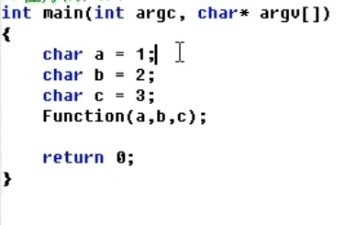
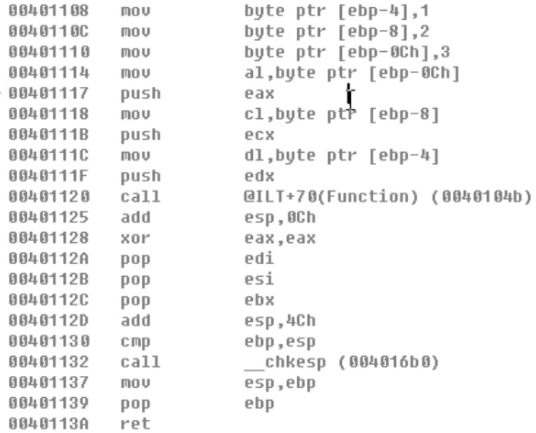
无论是char还是short类型,反汇编中都是以4个字节传递
结论:整数类型的参数,一律使用int类型
—————————————————————————————————————
例子:
//函数定义:
void Plus(int x) //[ebp+8]
{
x = x + 1;
}
//入口函数
int main(int argc, char* argv[])
{
int x = 1; //[ebp-4]=1
Plus(x);
printf("%d\n",x);
return 0;
}
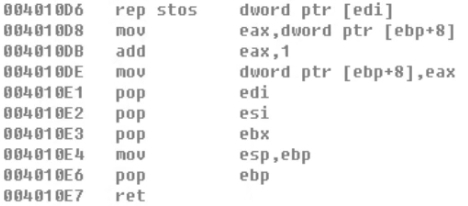
[ebp+8]放入了eax,eax+1,eax放入[ebp+8]
所以和[ebp-4]无关,printf出来为1
—————————————————————————————————————————————————
void Function()
{
int x = 1;
int y = 2;
int r;
int arr[10] = {1,2,3,4,5,6,7,8,9,10};
r = arr[1];
eax,duord ptr [ebp-30h]
dword ptr [ebp-0Ch],eax
r = arr[x];
ecx,duord ptr [ebp-4]
edx,dword ptr [ebp+ecx*4(int:四个字节)-34h] //ecx=1,1×4-34=30 结果:ebp-30h
r = arr[x+y];
eax,duord ptr [ebp-4]
eax,dword ptr [ebp-8]//eax=3
ecx,dword ptr [ebp+eax*4-34h] //eax=3,3×4=c,34-c=28,结果:ebp-28h
r = arr[x*2+y];
}
——————————————————————————————————————————————————
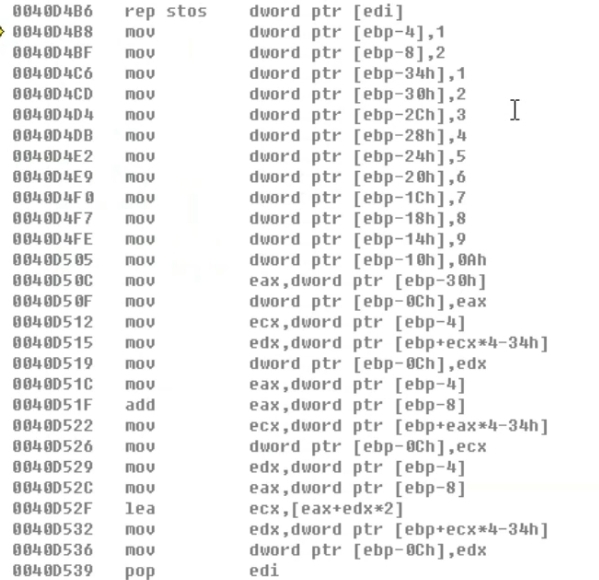
———————————————————————————————————————————————————
分配
当是空函数时,缓冲区分配40h
当有定义的变量时,缓冲区分配40h+
注:40h是不确定的,看是什么编译器
小于“本机尺寸”则按“本机尺寸”分配(若<4,则分配4个字节大小空间)
数组分配时,按类型大小分配
注:char a[3]与[4]分配的长度是一样的(都是四个字节,可以理解为熟人住标间)
参数:在函数调用的时候分配的值
局部变量:在函数执行的时候分配的值
数组
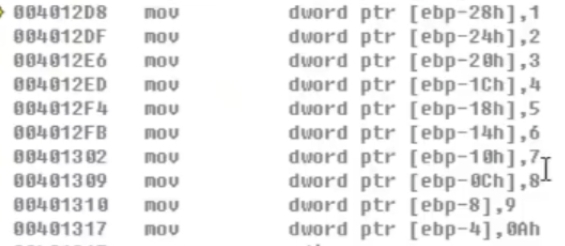
从地址最小的开始分配
多维数组
二维
int arr[3][4] = {
{1,2,3,4},
{5,6,7,8},
{9,7,6,5}
}
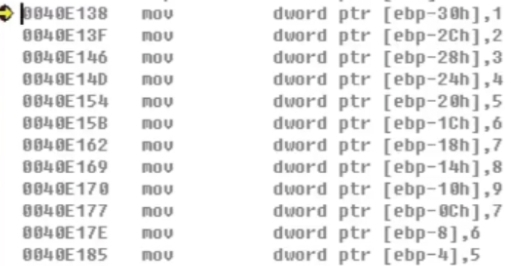
注:多维数组中,只有前面的[ ]可以不填
eg.
1.[ ][4]四个为一组
2.获取第一年第9个月的数据
arr[0][8]
编译器是如何找到这个数据的
arr[0*12 + 8]
三维
假设一共有5个班,每个班4个组,每组3个人
int arr[5][4][3] = {
{{1,2,3},{4,5,6},{7,8,9},{11,12,13}}, //0
{{11,12,13},{14,15,16},{17,18,19},{111,112,113}}, //1 arr[1][2][1] = 18
{{21,22,23},{24,25,26},{27,28,29},{211,212,213}}, //2 arr[1*4*3 + 2*3 +1]
{{31,32,33},{34,35,36},{37,38,39},{311,312,313}}, //3
{{41,42,43},{44,45,46},{47,48,49},{411,412,413}} //4 arr[3][3][1]
};
如果获取第2个班级、第3组、第2个人的年龄.
arr[1][2][1]
编译器如何计算:
arr[1*4*3 + 2*3 + 1]
结构体
格式:
struct st
{
int a;
char b;
short c;
};
void Function(person p)
{
st s;
s.a = 10;
s.b = 20;
s.c = 30;
}
注:st==int,char,float
—————————————————————————————————————————
偏移
struct Point
{
float x; 地址+0
float y; +4二级偏移
float z; +8
}
struct AA 假设AA地址为[0x41234567]
{
int 生命; 地址+4一级偏移
int 魔法; 地址+8
int 技能; 地址+c
Point 坐标; +10但存储的是Point的地址
float 移动速度;
char name[20]; //20字符 10中文
}
用法
常量赋值
struct st1
{
int a;
char b;
short c;
};
st x;全局变量
void Funtion() {
x.a=10;
x.b=20;
} 赋值
dword ptr [x (08427e49)1,0Ah
byte ptr [x+4 (00427e44)],14h
vord ptr [x+6 (60427e46)],0ffset Function+30h
void Funtion1() {
int a1=x.a;
}打印
局部变量
void Function(person p)
{
st s;
s.a = 10;
s.b = 20;
s.c = 30;
}
duord ptr [ebp-8],0Ah
byte ptr [ebp-4],14h
word ptr [ebp-21,0ffset Function+27h (0040d87)
—————————————————————————————————————————
数组赋值
struct st {
int arr[10];
};
st x;
void dgbfhj()
{
x.arr[0]=1;
}
————————————————————————————————————————
嵌套赋值
struct st1
{
int a;
};
struct st2
{
int x;
st1 aa;
};
st2 d;
void yfhigfg()
{
d.aa.a=2;
}



 浙公网安备 33010602011771号
浙公网安备 33010602011771号